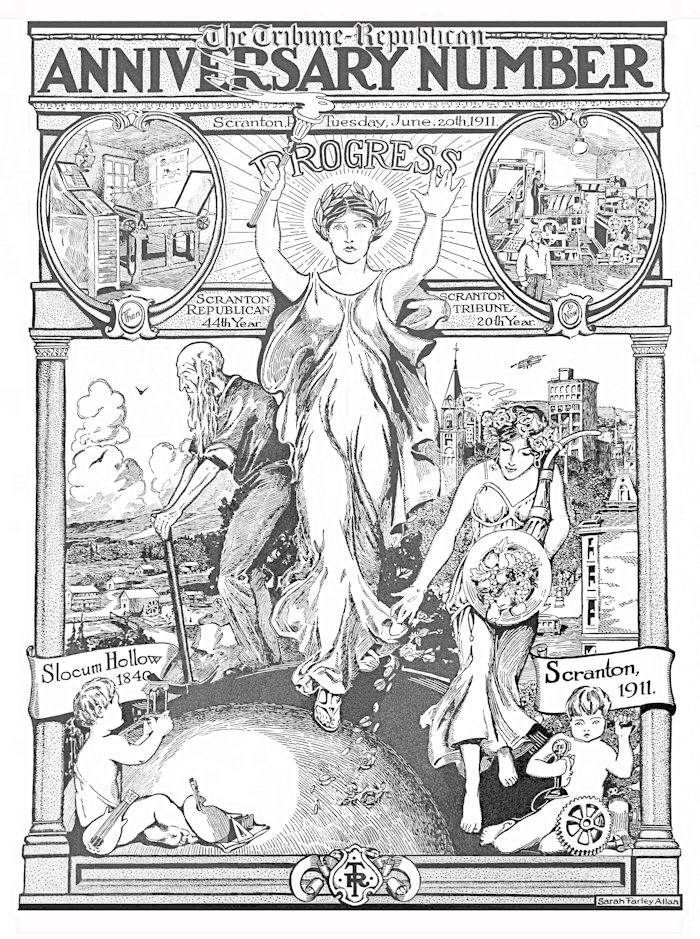 |
Farley-Allan
“Progress” Illustration – published in The Tribune Republican,
June
20, 1911, page one
The year 1911 marked the 44th Anniversary of the Scranton Republican
and the 20th Anniversary of the Scranton Tribune. The two papers merged
in 1910 and became the Tribune Republican. To commemorate both
milestones, the publishers of the newspaper commissioned artist Sarah
Farley Allan to illustrate the cover of a special anniversary
supplement.
At the top of the drawing, Farley-Allan depicted the
evolution of the newspaper business, from early manual typesetting, at
left - when movable type was placed in a press by hand, inked and an
impression made on paper - to a modern machine offset printing press,
at right.
Two signs, Slocum Hollow, 1840, at lower left, and
Scranton, 1911, at lower right, represent the city’s origins, followed
by seventy-one years of industrial, technological and cultural
progress, including, a thriving free press.
Farley-Allan’s skillfully detailed, multi-faceted
drawing, one of her best, is a portrait of Scranton’s history. The
centerpiece is the Goddess of Progress, who has laurel in her hair and
is holding a torch. She resembles a statue mounted atop a dome on San
Francisco’s City Hall, sculpted in 1896 by F. Marion Wells.
At right, the Roman Goddess, Abundantia, source of
abundance and prosperity, holds a cornucopia filled with fruit in one
arm, and distributes gold coins and flowers with the other. Behind her
is a view of downtown Scranton, including, City Hall and the Scranton
Board of Trade Building, a trolley car and a statue of George
Washington on Courthouse Square, the 10-story Mears Building, and a
Voisin biplane overhead, first flown in 1909.
At far left, an old man, leaning on a pick, represents
one of the original Slocum Hollow settlers who mined iron ore in the
nearby mountains. Visible in the background are several structures in
the village that borders Roaring Brook - the home of brothers, Ebenezer
and Benjamin Slocum; a gristmill with a water wheel that ground grain
into cereal; a school; a cooper shop and a sawmill. In Slocum Hollow,
Selden and George Scranton built four stone blast furnaces and
developed a process that combined Anthracite coal and iron ore to
produce pig iron, used to make rails for the Erie Railroad.
Two young boys are depicted in the bottom corners of
the drawing, The one at left has a lute by his side (representing
music) and is holding up a small structure with three pillars. Near his
feet are a paint palette with two brushes (art), a box with a row of
books (literature), and a triangle (geometry) propped against the box.
Under everything are large sheets, or perhaps an open book. The three
pillars likely represent Music, Art and Literature, core elements of
education and the young city’s culture. The boy at right is talking on
a telephone, a symbol of technological progress. A large gear wheel, a
hammer and other machine components represent industrial progress.
Throughout the drawing, Farley-Allan added flower
petals and foliage to further support her themes of growth and
development.
The original newspaper image (17 x 23”) provided by
Kim Harbester.
|

 Lackawanna
County, Pennsylvania, USGenWeb
Lackawanna
County, Pennsylvania, USGenWeb
